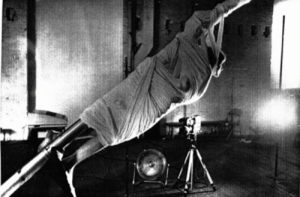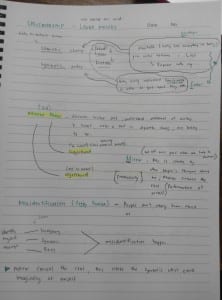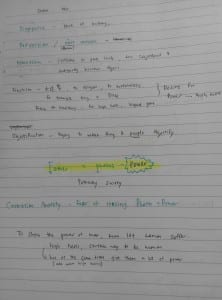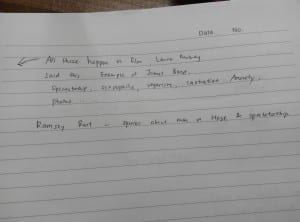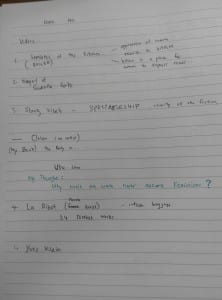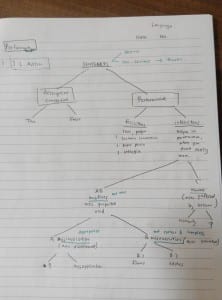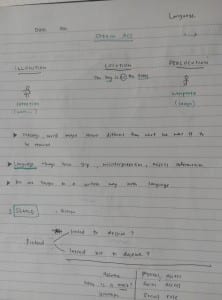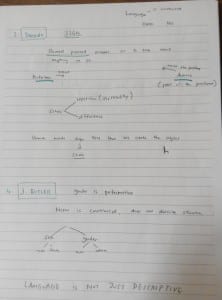Aspects of Alterity
The Questions of Otherness
From what I understand from the text, the Other refers to the things that unknown, not in our categories of understanding.
According to Aristotle, one of the nature of human is desire to know. Our goal is to convert unknown into known.
In this article, the author discussed and questioned on otherness by using most of the informations from two philosophers, Emmanuel Levinas and Gabriel Marcel. Both of them have different understanding of otherness. Levinas and Marcel have different kind of relationship with the other.
Levinas preserve the otherness of the other and respect the difference of the other and self. Levinas ideal intersubjective relationship is justice while Marcel ideal relationship is closer to love (relationship).
Justice – The aim is to maintain the gap and respect the difference of the other. Good fences make good neighbors has used to describe the justice between self and other.
Love – intimacy and participation. For Marcel, if otherness is merely relative, understanding the other is a possibility and the ethical concern is to understand better. One of the reason of Love is because of emphasis on maintaining the gap and understanding,
The nature of otherness
Two possibilities of reconciliation/reunion of conflict between absolute and relative characterizations of otherness by perspective of marcel n Levinas. Then look at the development of absolute otherness and relative otherness.
Otherness is everywhere even within the self, there is also otherness.
There are many questions asked around otherness. Question in Socially otherness are issues of identity, cross cultural, multiculturalism and nationalism. This is because of the development , change of the world and globalization.
Both Marcel and Levinas have important influence with their ways of characterizing otherness. These influences have been slowly developed otherness by few other philosopher including Derrida and Caputo (Levinas side) and Paul Ricoeur and Kearney (Marcel side).
As economic and social globalisation keep on reshape the way people interact, questions of otherness will more central to issues of identity. Multiracial family, dual nationality citizens. Questions such as, who am I? What or anything do we have in common? What it means to be other?
Levinas as articulating the conditions for the possibility of ethics (egoism, autarchic independence of Self, and alterity, the absolute otherness of Other).
What is absolute otherness?
In the text, it mentioned that to remain other is to be absolute and wholly other. This was the point of view from Levinas. He thinks that none is more significant than the claim that otherness, at least as encountered in divine神 and human persons, is absolute.
What is relative otherness?
Relative otherness, there are aspects of the other that is other and aspects of the other that are somewhat recognisable/understandable. This is mainly what Marcel’s characterise about otherness which is contrast with Levinas. There is no other which is totally other.
Question of is otherness absolute or relative?
Juxtaposition between deconstruction (absolute otherness) and hermeneutics诠释学 (relative otherness). Similitude相似, aspects of things and others that somehow familiar and understandable. Means communication with other is possible, justifiable. Alterity, aspects of things and others that is totally unfamiliar. Otherness, is the chiastic relationships of alterity and similitude. Both encountered each other as aspects of otherness (otherness in ourself or of other). No other which is absolute other.
Ethic伦理
Ethically, it characterising other as absolute otherness in order to protect the uniqueness of the other, this also able to reshape our assumptions about ethics and justice.
In this paragraph, author stated that relative otherness (alterity and similitude) is better way to preserve the uniqueness of other and to respect them compare to absolute otherness because absolute otherness is a levelling accounts of other.
To love is to respect the invisibility of the other.
The uniqueness of other’s cultural and ritual. I see them as the Other in the aspects of ethnic, belief, religion, culture and their ritual.
Epistemological
Epistemologically, it also characterising other as absolute otherness but in order to recognise the limitation of human knowing, incomplete, imperfect, perspectival透视 and contextual.
Index:
Emmanuel Levinas – was a French philosopher of Lithuanian Jewish ancestry who is known for his work related to Jewish philosophy, existentialism, ethics, and ontology. His notable ideas included The Other and The Face.
Gabriel Marcel -a French philosopher, playwright, music critic and leading Christian existentialist.For many years, Marcel hosted a weekly philosophy discussion group through which he met and influenced important younger French philosophers like Jean Wahl, Paul Ricoeur, Emmanuel Levinas, and Jean-Paul Sartre.Marcel recognized that human interaction often involved objective characterisation of “the other”, he still asserted the possibility of “communion” – a state where both individuals can perceive each other’s subjectivity.
alterity – the state of being other or different.In the phenomenological tradition it is usually understood as the entity in contrast to which an identity is constructed, and it implies the ability to distinguish between self and not-self, and consequently to assume the existence of an alternative viewpoint.
hermeneutics -the branch of knowledge that deals with interpretation, especially of the Bible or literary texts.
ethics -moral principles that govern a person’s behaviour or the conducting of an activity.
The Ontology of Performance-Representation without Reproduction by Peggy Phelan
Performance is only in the present, it will become representations of representations if performance is recorded or documented. Once performance is being reproduce it will break its own ontology. If a performance being perform again, this repetition will mark it as “different“.
There is only live and mediated.
The writer used the example of stolen painting in a museum. An artist Sophie Calle has collected descriptions of the painting from visitors and staff members. She transcribed the texts and displayed beside the photographs of the gallery. In this case, the painting continue presence by memory and descriptions but without the painting itself. The speech act of memory and description become performative expression with this representation. The description help to restate and restage the effort to remember what is lost. The act of writing towards disappearance, rather than towards preservation, that the after-effect of disappearance is the experience of subjectivity itself.
Memory, sights, love involve a full seeing of the Other‘s absence, a seeing which involve the acknowledgement of the Other’s presence. To acknowledge this presence is to acknowledge one’s absence.
Writing is reproduction of the Same meaning. For example the word cat, refer and representing the four legged furry animal with whiskers. But writing about a performance is often challenging, in order to make the words become performative utterance rather than constative utterance.
Again back to J.L.Austin, he has argued that speech has both performative and constative elements.
Performative – to say is to do or make something. I do, I promise, I beg.
Constative – describing things in the world.
Performative speech act is they enact the activity of their speech signify.
In performance, the body is metonymic 转喻 of self, of voice, of character,of ‘presence’ which then the performer disappear and representing something else – dance, music, sound, character, – art.
In employing the body metonymically, performance is able to resist the reproduction of metaphor 比喻. This include metaphor of gender. Metaphor of gender required unifies bodies which are biological different (genital).
A genre of performance called hardship art/ordeal art aims to create distinction of presence and representation, by using singular body as metonymy to experience pain.
Angelika Festa, she creates appear in order to disappear in her performances.
Angelika Festa, Untitled Dance (with fish and others), 30 to 31 May, 1987
Twenty-four hour performance in which Festa was suspended from a pole, wrapped in sheets. Her eyes were covered with silver tape, about two and a half feet from the bottom of the pole was a small black cushion which supported her bare feet. Her feet were projected onto a screen behind her in enlarged close-up. On a video monitor in front and to the left of her played a video tape loop of the embryology of a fish. Finally, on a smaller monitor facing her was a time-elapsed video documenting “the dance.”
Micheal Foucault thinks that the power is often in the one who listen and say nothing but not the one who speaks. Dustin Hoffman stated that performer is always in a female position in relation to power. What I understand from this statement is that the power is on spectator, to understand and think about the work, but not the performer. This shows the inequality of performer and spectator.
Index:
Ontology – is the philosophical study of the nature of being, becoming, existence, or reality, as well as the basic categories of being and their relations.
Peggy Phelan – an American feminist scholar, one of the founders of Performance Studies International and was chair of New York University’s Department of Performance Studies. She is the author ofUnmarked (1993), Mourning Sex (1997), and Art and Feminism (2001).
Roland Barthes – was a French literary theorist, philosopher, linguist, critic, and semiotician. Barthes’ ideas explored a diverse range of fields and he influenced the development of schools of theory including structuralism, semiotics, social theory, anthropology and post-structuralism.
William Forsythe – an American dancer and choreographer resident in Frankfurt am Main in Hessen. He is known internationally for his work with the Ballet Frankfurt and The Forsythe Company. Recognized for the integration of ballet and visual arts, his vision of choreography as an organizational practice has inspired him to produce numerous Installations, Films, and Web based knowledge creation.
Dustin Hoffman – American actor with a career in film, television, and theatre since 1960. He has been known for his versatile portrayals of antiheroes and vulnerable characters.
Choreographing Object (videos)
William Forsythe’s choreographing object works are very interesting to me. By using object and make the spectator become the performer, a tactic of shifting the roles. He somehow plays with the human natural reaction (which can be think as performance) by making or choreographing objects. I can see realness because the movements of the spectators or the players (people who play in the particular space) are not choreographed, it is not representation.
